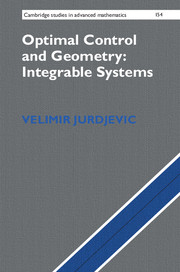Book contents
- Frontmatter
- Contents
- Acknowledgments
- Introduction
- Chapter 1 The Orbit Theorem and Lie determined systems
- Chapter 2 Control systems: accessibility and controllability
- Chapter 3 Lie groups and homogeneous spaces
- Chapter 4 Symplectic manifolds: Hamiltonian vector fields
- Chapter 5 Poisson manifolds, Lie algebras, and coadjoint orbits
- Chapter 6 Hamiltonians and optimality: the Maximum Principle
- Chapter 7 Hamiltonian view of classic geometry
- Chapter 8 Symmetric spaces and sub-Riemannian problems
- Chapter 9 Affine-quadratic problem
- Chapter 10 Cotangent bundles of homogeneous spaces as coadjoint orbits
- Chapter 11 Elliptic geodesic problem on the sphere
- Chapter 12 Rigid body and its generalizations
- Chapter 13 Isometry groups of space forms and affine systems: Kirchhoff's elastic problem
- Chapter 14 Kowalewski–Lyapunov criteria
- Chapter 15 Kirchhoff–Kowalewski equation
- Chapter 16 Elastic problems on symmetric spaces: the
- Chapter 17 The non-linear Schroedinger's equation and Heisenberg's magnetic equation–solitons
- References
- Index
Introduction
Published online by Cambridge University Press: 05 May 2016
- Frontmatter
- Contents
- Acknowledgments
- Introduction
- Chapter 1 The Orbit Theorem and Lie determined systems
- Chapter 2 Control systems: accessibility and controllability
- Chapter 3 Lie groups and homogeneous spaces
- Chapter 4 Symplectic manifolds: Hamiltonian vector fields
- Chapter 5 Poisson manifolds, Lie algebras, and coadjoint orbits
- Chapter 6 Hamiltonians and optimality: the Maximum Principle
- Chapter 7 Hamiltonian view of classic geometry
- Chapter 8 Symmetric spaces and sub-Riemannian problems
- Chapter 9 Affine-quadratic problem
- Chapter 10 Cotangent bundles of homogeneous spaces as coadjoint orbits
- Chapter 11 Elliptic geodesic problem on the sphere
- Chapter 12 Rigid body and its generalizations
- Chapter 13 Isometry groups of space forms and affine systems: Kirchhoff's elastic problem
- Chapter 14 Kowalewski–Lyapunov criteria
- Chapter 15 Kirchhoff–Kowalewski equation
- Chapter 16 Elastic problems on symmetric spaces: the
- Chapter 17 The non-linear Schroedinger's equation and Heisenberg's magnetic equation–solitons
- References
- Index
Summary
Upon the completion of my book on geometric control theory, I realized that this subject matter, which was traditionally regarded as a domain of applied mathematics connected with the problems of engineering, made important contributions to mathematics beyond the boundaries of its original intent. The fundamental questions of space control, starting with the possibility of navigating a dynamical system from an initial state to a given final state, all the way to finding the best path of transfer, inspired an original theory of differential systems based on Lie theoretic methods, and the quest for the best path led to the Maximum Principle of optimality. This theory, apart from its relevance for the subject within which it was conceived, infuses the calculus of variations with new and fresh insights: controllability theory provides information about the existence of optimal solutions and the Maximum Principle leads to the solutions via the appropriate Hamiltonians. The new subject, a synthesis of the calculus of variations, modern symplectic geometry and control theory, provides a rich foundation indispensable for problems of applied mathematics.
This recognition forms the philosophical underpinning for the book. The bias towards control theoretic interpretations of variational problems provides a direct path to Hamiltonian systems and reorients our understanding of Hamiltonian systems inherited from the classical calculus of variations in which the Euler–Lagrange equation was the focal point of the subject. This bias also reveals a much wider relevance of Hamiltonian systems for problems of geometry and applied mathematics than previously understood, and, at the same time, it offers a distinctive look at the theory of integrable Hamiltonian systems.
This book is inspired by several mathematical discoveries in the theory of integrable systems. The starting point was the discovery that the mathematical formalism initiated by G. Kirchhoff to model the equilibrium configurations of a thin elastic bar subjected to twisting and bending torques at its ends can be reformulated as an optimal control problem on the orthonormal frame bundle of ℝ3, with obvious generalizations to any Riemannian manifold.
- Type
- Chapter
- Information
- Optimal Control and Geometry: Integrable Systems , pp. xi - xxPublisher: Cambridge University PressPrint publication year: 2016



